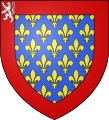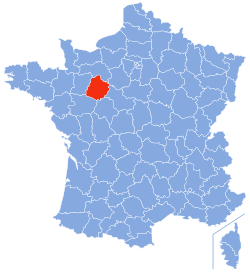Sarthe
Sarthe (French pronunciation: [saʁt]) is a department of the French region of Pays de la Loire situated in the Grand-Ouest of the country. It is named after the River Sarthe, which flows from east of Le Mans to just north of Angers.
Sarthe | |
|---|---|
Prefecture building of the Sarthe department, in Le Mans | |
.svg.png) Flag  Coat of arms | |
 Location of Sarthe in France | |
| Coordinates: 48°17′N 0°13′E | |
| Country | France |
| Region | Pays de la Loire |
| Prefecture | Le Mans |
| Subprefectures | La Flèche Mamers |
| Government | |
| • President of the General Council | Roland du Luart |
| Area | |
| • Total | 6,206 km2 (2,396 sq mi) |
| Population (2016) | |
| • Total | 567,561 |
| • Rank | 46th |
| • Density | 91/km2 (240/sq mi) |
| Time zone | UTC+1 (CET) |
| • Summer (DST) | UTC+2 (CEST) |
| Department number | 72 |
| Arrondissements | 3 |
| Cantons | 21 |
| Communes | 354 |
| ^1 French Land Register data, which exclude estuaries, and lakes, ponds, and glaciers larger than 1 km2 | |

History
In the late 18th century, before it was officially Sarthe, the nobility built their Mansions and Chateaus there, as an escape from Paris.
The department was created during the French Revolution on 4 March 1790, pursuant to the law of 22 December 1789, starting from a part of the province of Maine. The latter was divided into two departments, Sarthe to the east and Mayenne to the west.[1]
In Roman times, this province contained the city of Mans, and many of its ruins are still standing. The Roman Thermal Bathhouse attracts many tourists, as does the Theater of Aubigné-Racan, both located on the outskirts of Anjou, Maine, and Touraine.
Marin Mersenne, perhaps the most important scientific figure in the early 17th century, was born in the vicinity of Sarthe.
Geography
The department of Sarthe is at the north end of the administrative region of Pays de la Loire. It is south of Normandy and on the southern edge of the Armorican Massif. It is bordered by the departments of Orne, Eure-et-Loir, Loir-et-Cher, Indre-et-Loire, Maine-et-Loire and Mayenne.
Approximately 300,000 people, comprising more than half of the department's population, live in Le Mans, its conurbation, or the essentially urban communes close by. The rest of the department retains a rural character, with agriculture as the chief part of the economy.
The arrival of the railways in 1854 boosted trade for the local economy. A TGV connection was constructed in 1989, connecting the community to high-speed transport.
In terms of road connections, the A11 autoroute, which was constructed to Le Mans from the east in 1978, enhances Sarthe's strategic position as the gateway to the French west.
Demographics
Population development since 1801:
| Year | Pop. | ±% p.a. |
|---|---|---|
| 1801 | 388,143 | — |
| 1806 | 410,380 | +1.12% |
| 1821 | 428,432 | +0.29% |
| 1831 | 457,372 | +0.66% |
| 1841 | 470,535 | +0.28% |
| 1851 | 473,071 | +0.05% |
| 1861 | 466,155 | −0.15% |
| 1872 | 446,603 | −0.39% |
| 1881 | 438,917 | −0.19% |
| 1891 | 429,737 | −0.21% |
| 1901 | 422,699 | −0.16% |
| 1911 | 419,370 | −0.08% |
| 1921 | 389,235 | −0.74% |
| 1931 | 384,619 | −0.12% |
| 1936 | 388,519 | +0.20% |
| 1946 | 412,214 | +0.59% |
| 1954 | 420,393 | +0.25% |
| 1962 | 443,019 | +0.66% |
| 1968 | 461,839 | +0.70% |
| 1975 | 490,385 | +0.86% |
| 1982 | 504,768 | +0.41% |
| 1990 | 513,654 | +0.22% |
| 1999 | 529,851 | +0.35% |
| 2006 | 553,484 | +0.63% |
| 2011 | 565,718 | +0.44% |
| 2016 | 567,561 | +0.07% |
| source:[2] | ||
Politics
The department was the electoral base of former Prime Minister Francois Fillon, who since 2012 sits in the National Assembly of France for a constituency in central Paris.
Current National Assembly Representatives
Tourism
.jpg) Stained glass in Le Mans Cathedral
Stained glass in Le Mans Cathedral
 Church of La Ferté-Bernard
Church of La Ferté-Bernard
- Château de Courtanvaux
See also
- Arrondissements of the Sarthe department
- Cantons of the Sarthe department
- Circuit de la Sarthe (cycling), an annual road cycling race
- Circuit de la Sarthe, a motor racing track
- Communes of the Sarthe department
References
- The Sarthe region
- Site sur la Population et les Limites Administratives de la France
- http://www.assemblee-nationale.fr/
- "Weekly auto agenda: Le Mans". The Independent. 11 June 2010. Retrieved 22 April 2011.
External links
| Wikivoyage has a travel guide for Sarthe. |
- Prefecture (in French)
- General Council (in French)
- Sarthe information (in French)